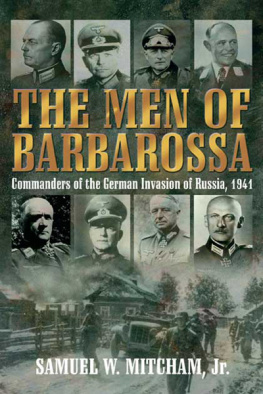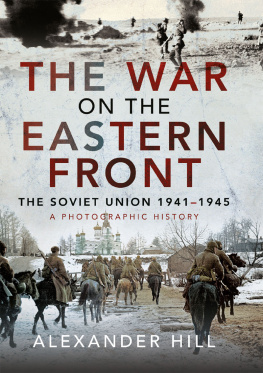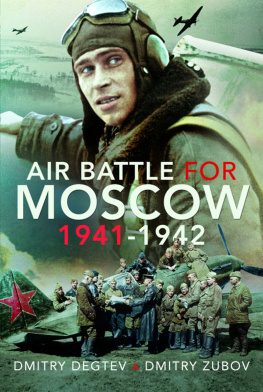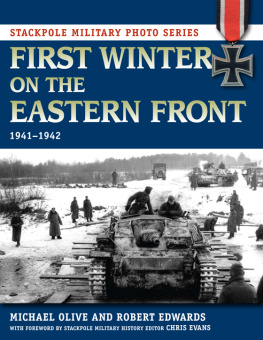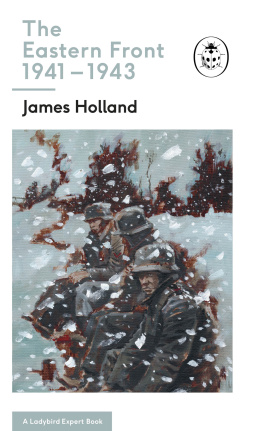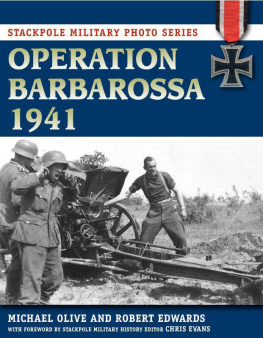Contents
Guide
Pagebreaks of the print version
- i
- ii
- i
- ii
- iii
- iv
- v
- vi
- vii
- viii
This book is an historical study of the events of October 1941 in the Viazma pocket, based on documents found in the Russian Federations Central Archive of the Ministry of Defense in Podolsk, Moscow Oblast, the German Bundesarchiv, and the US National Archives.
The author Mikhail Filippenkov describes the events that took place through the simultaneous, comparative analysis of Soviet and German combat reports according to time, and in the manner of reporting from the places of those events as they happened. The author writes about these events with chronological accuracy, not on the level of army headquarters and higher, but exclusively on the level of the combat formations down to the division-level, and with concrete geographical reference to the combat maps of those times.
Particular attention is given to the events that took place in the vicinity of Sychevka in Smolensk Oblast, since what happened there has never been deeply researched or examined by anyone in Russia. Unfortunately, research must rely primarily on the combat reports and combat documents of the units of the Wehrmachts Panzergruppe 3, since almost no documents on the Soviet side have been preserved. They were either destroyed together with the units and formations trapped within the Viazma pocket, or destroyed at an order from above to those units and formations which managed to escape encirclement more or less intact, in order to erase any record of the disaster.

Mikhail Filippenkov was born in Moscow in 1959. A lawyer by education and training, until 1991 he worked in a department of the USSR Ministry of Internal Affairs responsible for the struggle against embezzlement and speculation. In 1991, he was released from service in the rank of major of the militia. Until 1998 he worked in a business involved with the international trade of consumer goods. After 1998 and to the present, Filippenkov has been a legal advocate for civilian rights. Simultaneously, he has taken an interest in research into the history of Smolensk Oblast his fathers native land. Filippenkov is married and has a son, Aleksei Mikhailovich Filippenkov, an executive policy-maker and economist who is also busy with literary efforts, and who has recently written the novel Voronka [The Shell Hole] on the events of the First World War on the Western Front.
Helion & Company Limited
26 Willow Road
Solihull
West Midlands
B91 1UE
England
Tel. 0121 705 3393
Fax 0121 711 4075
Email:
Website: www.helion.co.uk
Twitter: @helionbooks
Visit our blog http://blog.helion.co.uk/
Published by Helion & Company 2016
Designed and typeset by Mach 3 Solutions Ltd (www.mach3solutions.co.uk)
Cover designed by Paul Hewitt, Battlefield Design (www.battlefield-design.co.uk)
Printed by Gutenberg Press Limited, Tarxien, Malta
Text Michael Filippenkov 2015. English edition translated and edited by
Stuart Britton, Helion & Company Limited 2015.
Images as individually credited.
Maps drawn by Paul Hewitt, Battlefield Design (www.battlefield-design.co.uk)
Helion & Company Limited 2013
Originally published as Viazemskaia golgofa Generala Koneva [General Konevs Viazma Golgotha] (Moscow: Veche, 2012).
Every reasonable effort has been made to trace copyright holders and to obtain their permission for the use of copyright material. The author and publisher apologize for any errors or omissions in this work, and would be grateful if notified of any corrections that should be incorporated in future reprints or editions of this book.
ISBN 978-1-910777-37-4
eISBN 978-1-911096-98-6
British Library Cataloguing-in-Publication Data.
A catalogue record for this book is available from the British Library.
All rights reserved. No part of this publication may be reproduced, stored in a retrieval system, or transmitted, in any form, or by any means, electronic, mechanical, photocopying, recording or otherwise, without the express written consent of Helion & Company Limited.
For details of other military history titles published by Helion & Company Limited contact the above address, or visit our website: http://www.helion.co.uk.
We always welcome receiving book proposals from prospective authors.
Contents
List of Illustrations
List of Maps
In colour section
1 The German 3rd Panzer Group at the boundary between the 30th and 19th armies. (Source: D.M. Glantz, Atlas)
2 Situation Eastern Theatre (according to German data) at the end of 2.10.41 at 2000 hours. (Source: D.M. Glantz, Atlas)
3 Counter-attack by Operational Group Boldin, 3-6 October 1941.
4 Situation area of Viazma on 5.10.41. (Source: D.M. Glantz, Atlas)
5 Situation at 2000 on 7.10.41. (Source: D.M. Glantz, Atlas)
6 Situation at 2100 on 8.10.41. (Source: D.M. Glantz, Atlas)
7 Situation on 9.10.41. (Source: D.M. Glantz, Atlas)
8 Situation on 11.10.41. (Source: D.M. Glantz, Atlas supplemented by author)
Glossary of German Units and Formations
Abteilung Battalion with less than five companies
Armee Army
Artillerie Artillery
Aufklrung Reconnaissance
Bataillon Battalion of five companies
Batterie Battery
Division, Divisionen Division, Divisions
Flak Anti-aircraft
Heer Army
Heeresgruppe Army Group
Heeresgruppe Mitte Army Group Center
Infanterie Infantry
Kampfgruppe, Kampfgruppen Combat or Battle Group
Kavallerie Cavalry
Kompanie Company
Korps Corps
Kradschtzen motorcycle infantry
mot. abbreviation for motorized
Panzer-Abteilung armored battalion
Panzer-Division armored division
Panzergruppe Panzer Group
Panzertruppen Armored troops
Pioniere Pioneer
Radfahr Bicycle mounted unit
Regiment, Regimenter Regiment, Regiments
Schtzen Motorized infantry
Schwadron Squadron
Zug Platoon
Preface
The events of the Great Patriotic War [the Russian name for conflict on the Eastern Front of the Second World War] are receding ever further into the past, yet interest in the savage battles of that time is not flagging. Much has already been written about that war in both scholarly literature and memoirs by direct participants in those events, as well as by Russian and foreign scholars.
Fortunately, in recent years previously closed archives and materials have become open to all, which allows a fresh look at those severe trials that fell to the fate of our fathers and grandfathers, who are becoming fewer on this earth with every passing day. Thus, today documents are the primary, mute but impartial witnesses of that heroic era.
However, despite the fact that the Communist regime collapsed more than 20 years ago, for some reason access is still closed to the directives of the Stavka of the Supreme High Command; to documents of the Party and Komsomol [Communist Youth League] organizations and to the political communications of their leaders; to materials of the military procurators and tribunals; and without exception to all materials that contain maps on a 50-kilometer scale. Thus, it has been necessary to search through a mass of scattered documents and literally on the basis of fragments to assemble and analyze information that is simply impossible to refute. It has been possible to retrieve the long-forgotten names of people, who paid with their lives for the ambitions of those generals who had no gift in leadership or command. Documents have been preserved that point directly to the fact that the Red Army was adequately provided with weapons and equipment, which were in no way inferior to the enemys in quality or number. The quality of staff work and the level of training of our staff officers were not inferior to those of their German counterparts, even with all their meticulousness and punctuality, and in many cases were superior. The military knowledge and command skills of commanders up to the division level in the majority of cases were sufficiently progressive for that time and in those circumstances. Our soldiers knew how to fight competently, and their tenacity and courage were repeatedly mentioned by the enemy in their summary reports and messages. But all of this was reduced to nil by the orders from the commands of




